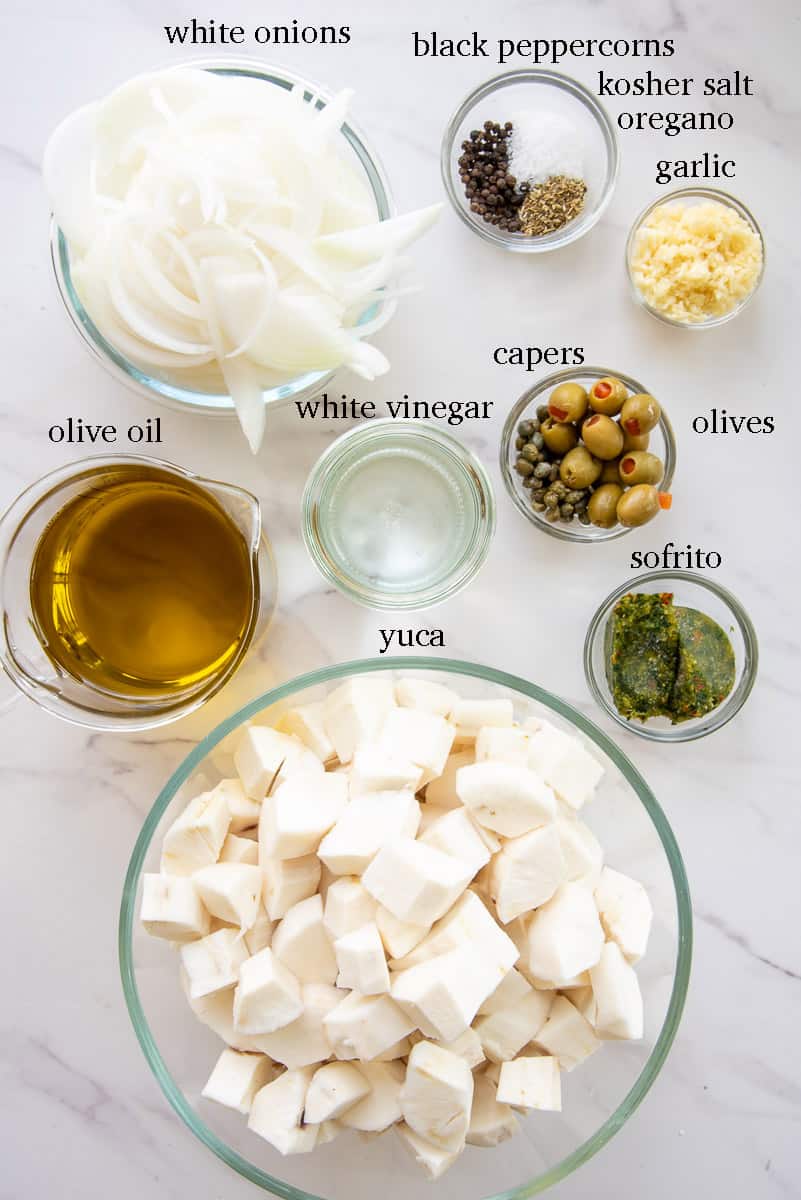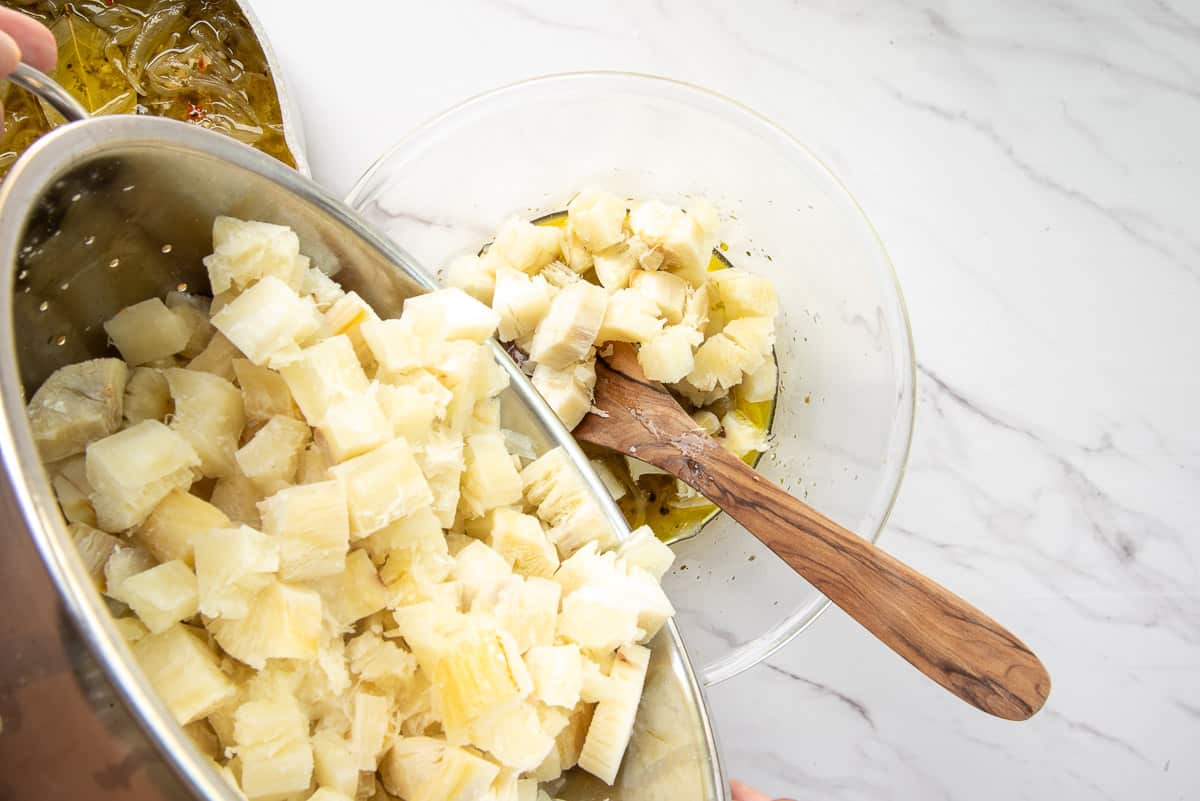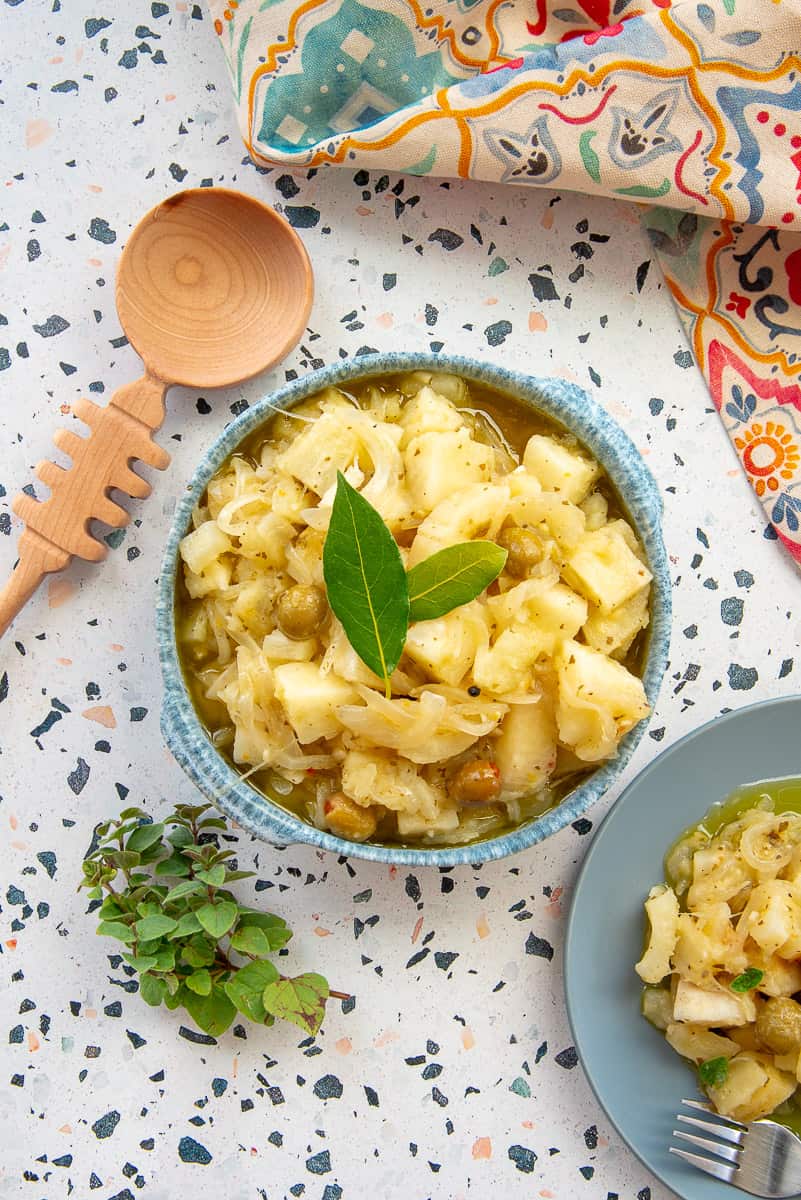Yuca en Escabeche, or pickled yuca salad, is a Puerto Rican side dish with boiled, creamy yuca (cassava) tossed in a piquant sauce of vinegar, onions, and spices. This family favorite tastes great when served with steamed white rice or as a side dish to pork or chicken. You’ll love how simple it is to prepare, and what’s more, it tastes better with time.
What Is Yuca En Escabeche?
Yuca is a long tuber with a shiny, woody peel. Also known as cassava or manioc, yuca is a major dietary staple in many parts of South America, Africa, and the Caribbean. Yuca has a starchy, creamy white or yellow flesh, which is toxic when eaten raw. Many cultures eat it boiled, fried, mashed, or stewed with other ingredients. It’s very similar to potatoes in that its mild flavor makes it great for pairing with bolder flavors, as in this escabeche recipe.
In the States, yuca is more commonly used in the form of tapioca, which is used to thicken sauces or pie filling. Another popular use for yuca is in the form of a meal known as farofa. Some countries in Africa pound yuca into a pounded meal known as fufu.
Escabeche is a sauce of vinegar and oil simmered with alliums and herbs to create a piquant dressing. You might recognize it from my Guineitos con Mollejas en Escabeche recipe. Escabeche, or escovitch, in the West Indies, is a popular dressing for vegetables, proteins, and tubers. Often, it is served with rice or another mild-tasting ingredient to cut through the tart vinegary flavor. With its mild, creamy flesh, Yuca is the perfect ingredient to toss this zingy escabeche sauce in.
Where Can I Find Yuca?
Yuca is fast becoming a popular ingredient here in the States. I can always find yuca at my local mainstream grocery store, usually in the produce aisle’s tropical fruits and vegetables section. Yuca is a great source of carbohydrates and also contains a good amount of niacin, vitamin C, riboflavin, and thiamine. It is a major source of nourishment in many African, South American, and Caribbean countries. As a result, you can often find yuca in African or Hispanic markets if your grocery store doesn’t sell it.
Buy yuca roots that are wide and straight, with minimal hooks and crooks. Straight sides make it easier to peel the woody bark from the yuca.
What Do I Need To Make Yuca En Escabeche?
To make yuca en escabeche, you need yuca, good-quality white vinegar, extra-virgin olive oil, white onions, garlic, olives, capers, sofrito, black peppercorns, kosher salt, and dried oregano leaves. I also like adding a bay leave to the escabeche sauce, but that’s optional.
You also need a pot to boil the cassava and a skillet to prepare the escabeche.
Why Do I Have To Cook Yuca?
Yuca is categorized as either sweet or bitter depending on the amount of cyanogenic glucosides it contains. Sweet cassava contains the least toxicity, while bitter cassava contains double the amount of toxins. For this reason, it’s important to cook yuca properly to prevent cyanide intoxication. That’s very simple, so don’t fret about making yourself or anyone else sick.
To peel yuca:
- Cut the root into manageable pieces, about 3-4 inches.
- Make a slit, lengthwise, down the yuca.
- Take the blade of your knife and flick up the peel at the slit. It’ll sound like you’re opening a cardboard box.
- Carefully lift the woody peel away from the rest of the flesh with the knife blade.
- Complete peeling the remaining yuca pieces this way.
- Cut the cassava into 1-inch thick slabs, then into 1-inch strips, and finally, into 1-inch chunks.
After peeling the yuca, cut it into 1-inch chunks. Put these yuca chunks into a large stockpot and cover it with 4 inches of cold water. Allow the yuca to soak in the water while you prep the rest of the ingredients.
Drain the yuca and rinse it under cold water. Drain this water and fill the pot up with new cold water to cover the yuca 4 inches. Bring the water up to a boil over medium-high heat. Allow to yuca to simmer for 20-25 minutes, or until fork-tender.
How Do I Make The Escabeche Sauce?
Make the escabeche sauce while the yuca simmers.
Begin heating the olive oil in a non-reactive skillet over medium-low heat. Add the onions to the oil in the pan after 1 minute or when the oil smells fragrant. Gently sauté the onions for 5 minutes or until they become translucent and soft, stirring occasionally. This step of slowly cooking the onions by themselves not only infuses the oil with their flavor but also mellows out the pungency of the onions.
Can I Use A Different Kind Of Onion?
I prefer white onions when making escabeche because they’re more assertive and combine with the yuca better. You can replace the white onions in this recipe with yellow or red onions. Avoid using sweet onions because their flavor does nothing for this recipe.
Add the garlic and the sofrito to the onions in the pan after 5 minutes. Allow their flavors to infuse into the oil for another 3-4 minutes, stirring once every minute.
Do I Have To Add Olives And Capers?
Add the olives, capers, black peppercorns, kosher salt, dried oregano, and a bay leaf to the pan after the garlic and sofrito have a chance to infuse. Stir these ingredients into the onions to combine everything. Simmer the mixture in the pan for 3-4 minutes.
Olives and capers are necessary in this yuca en escabeche recipe because they give it umami. Without it, the escabeche will lack depth of flavor. You can omit them if you absolutely hate or are allergic to them. Replace that missing umami by adding 1/2 teaspoon of Accent or MSG. You can also use just the juice of the olives and capers– 1 tablespoon of each– although I don’t know why you’d have them if you hated them.
What Can I Substitute The Vinegar With?
Add the vinegar to the pot once the spices have simmered with the onion mixture for 4 minutes. Simmer the mixture for another 5 minutes to marry the flavors. Turn off the stove and let the escabeche cool as the yuca finishes cooking.
If you don’t have white distilled vinegar, replace it with white wine vinegar or a combination of lemon, lime, and orange juice. Use 1 cup of fresh lemon juice to a 1/2 cup (each) of fresh lime and fresh Naval or Valencia orange juice.
How Far Ahead Can I Make Yuca En Escabeche?
Making yuca escabeche ahead gives the flavors of the escabeche time to infuse into the mild yuca flesh, making it taste better and better as the flavors marry. For this reason, you can (and should) make yuca en escabeche a few hours before serving it. I often make it the evening before I plan to serve it. If you can’t make the whole recipe on the same day, you can make the escabeche sauce up to a week ahead and store it in a covered container in the fridge.
Drain the yuca in a colander once the cooking time is finished. While the yuca drains in the colander, add half of the escabeche to a large bowl.
How Long Does It Need To Pickle?
Pour the drained yuca into the bowl on top of the escabeche, then pour the rest of the escabeche sauce over the yuca.
Use salad forks or a wide spoon to fold the yuca into the escabeche until it is completely coated. Cover the bowl and allow the escabeche to pickle the yuca for at least 1 hour before serving.
How Is Yuca En Escabeche Served?
After an hour, preferably after 4 hours, stir the yuca en escabeche again.
Yuca en escabeche is typically served at room temperature, but you can serve it cold or even slightly warmed in the microwave. Just spoon it onto your plate(s) and enjoy it. Many people don’t like chewing on the peppercorns, though they’re safe to eat. You can tell your guests to move them to the side or fish them out yourself. I also do the former because I ain’t got time to baby people.
How Do I Store Leftovers?
Store leftover yuca en escabeche in an airtight container in the refrigerator for 1 week. Be sure to stir the mixture before serving it to ensure you get all the pickling liquid on your yuca.
Can I Freeze It?
I have successfully frozen yuca en escabeche for up to 3 months. Allow it to infuse for 2 hours at room temperature after mixing in the escabeche. Transfer the yuca to a freezer-safe container and store it in the freezer for up to 3 months.
To thaw frozen yuca en escabeche, just put the container in the fridge overnight. The next day, stir everything together again before warming or serving cold.
What Recipes Go Well With Yuca En Escabeche?
Yuca en escabeche is the perfect side dish for Chuletas Fritas, Pork Chops with Mofongo Stuffing, or Grilled Garlic Herb Lamb Chops. Add a fresh garden salad or my Charred Broccolini and you’ll have a well-balanced, delicious meal.
Yuca en Escabeche is a classic Puerto Rican side dish that makes a great addition to your next meal. You’ll love how simply it all comes together and your family will love its tropical flair. Pin this recipe to your side dishes board and don’t forget to share it with your friends and family!

Yuca en Escabeche (Pickled Yuca)
at Sense & EdibilityEquipment
- large stockpot
- 12-inch skillet
Ingredients
For the Boiled Yuca
- 4 pounds (2 kilograms) yuca peeled and cut into 1-inch cubes (see notes)
- 10 cups water
- kosher salt
For the Escabeche Sauce
- 1 3/4 cups (420 milliliters) extra-virgin olive oil
- 1 cup (250 milliliters) distilled white vinegar
- 2 large white onions peeled, trimmed and sliced (2 heaping cups or 450 grams)
- 3 large cloves garlic minced (about 1 heaping tablespoon or 20 grams)
- 1 tablespoon (20 grams) sofrito
- 20 (about 1/4 cup or 45 grams) manzanilla olives stuffed with pimentos
- 1 heaping tablespoon (12 grams) capers
- 1/2 tablespoon (4 grams) black peppercorns
- 1 teaspoon (6 grams) kosher salt plus more to taste
- 1/2 teaspoon (1 gram) dried oregano leaves
- 1 large bay leaf optional
Instructions
Soak the Yuca
- Put the yuca chunks into a large stockpot and cover it with 4 inches of cold water. Allow the yuca to soak in the water while you prep the rest of the ingredients or for 20 minutes.
Boil the Yuca Until Tender
- Drain the yuca and rinse it under cold water. Drain this water and fill the pot up with new cold water to cover the yuca 4 inches. Bring the water up to a boil over medium-high heat. Allow to yuca to simmer for 20-25 minutes, or until fork-tender.
Prepare the Escabeche Sauce While the Yuca Cooks
- Begin heating the olive oil in a non-reactive skillet over medium-low heat. Add the onions to the oil in the pan after 1 minute or when the oil smells fragrant. Gently sauté the onions for 5 minutes or until they become translucent and soft, stirring occasionally.
- Add the garlic and the sofrito to the onions in the pan after 5 minutes. Allow their flavors to infuse into the oil for another 3-4 minutes, stirring once every minute.
- Add the olives, capers, black peppercorns, kosher salt, dried oregano, and a bay leaf to the pan after the garlic and sofrito have a chance to infuse. Stir these ingredients into the onions to combine everything. Simmer the mixture in the pan for 3-4 minutes.
- Add the vinegar to the pot once the spices have simmered with the onion mixture for 4 minutes. Simmer the mixture for another 5 minutes to marry the flavors. Turn off the stove and let the escabeche cool as the yuca finishes cooking.
Marinate the Yuca in the Escabeche Sauce
- Drain the yuca in a colander once the cooking time is finished.
- While the yuca drains in the colander, add half of the escabeche to a large bowl. Pour the drained yuca into the bowl on top of the escabeche, then pour the rest of the escabeche sauce over the yuca.
- Use salad forks or a wide spoon to fold the yuca into the escabeche until it is completely coated. Cover the bowl and allow the escabeche to pickle the yuca for at least 1 hour, preferably 4 hours, before serving.
- After an hour, preferably after 4 hours, stir the yuca en escabeche again, then serve.Yuca en escabeche is typically served at room temperature, but you can serve it cold or even slightly warmed in the microwave. Just spoon it onto your plate(s) and enjoy it.
Notes
- Cut the whole root into manageable pieces that are about 3-4 inches.
- Make a slit, lengthwise, down the yuca. Take the blade of your knife and flick up the peel at the slit. It'll sound like you're opening a cardboard box.
- Carefully lift the woody peel away from the rest of the flesh with the knife blade. Complete peeling the remaining yuca pieces this way.
- Cut the cassava into 1-inch thick slabs, then into 1-inch strips, and finally, into 1-inch chunks.
- Replace the white onions in this recipe with yellow or red onions. Avoid using sweet onions because their flavor does nothing for this recipe.
- You can omit the olives and capers if you absolutely hate or are allergic to them:
- Replace the olives and capers umami with 1/2 teaspoon of Accent or MSG, or 1 tablespoon (15ml) of the juice of the olives and capers.
- Replace the white distilled vinegar with white wine vinegar or a combination of (1 cup/240 ml) fresh lemon juice, 1/2 cup or 120ml (each) fresh lime and fresh Naval or Valencia orange juice.
- Yuca is usually found in the produce aisle's tropical fruits and vegetables section or in African or Hispanic markets labeled cassava, manioc, or yuca.
- Buy yuca roots that are wide and straight, with minimal hooks and crooks to peel the woody bark from the yuca easily.
- It's important to cook yuca thoroughly to prevent cyanide intoxication.
- If you can't make the whole recipe on the same day, you can make the escabeche sauce up to a week ahead and store it in a covered container in the fridge.
- Though the peppercorns are safe to eat, you can tell your guests to move them to the side or fish them out and discard them yourself.
- Store leftover yuca en escabeche in an airtight container in the refrigerator for 1 week.
- Be sure to stir the mixture before serving it to ensure you get all the pickling liquid on your yuca.
- Allow the yuca to infuse for 2 hours at room temperature after mixing in the escabeche.
- Transfer the yuca to a freezer-safe container and store it in the freezer for up to 3 months.
- To thaw frozen yuca en escabeche, just put the container in the fridge overnight.
- The next day, stir everything together again before warming or serving cold.



















My kids have been on a yuca fries kick lately, but I’m so intrigued by this pickling process! I took a part of the yuca I had an do this. It was a delicious addition to meats and veggies!
Lauren, it’s a great way to add a different starch to any meal. Give it a try!
I made your yuca en escabeche to pair with grilled chicken and everybody cleaned their plates! Your recipe broke down every detail so well I’m planning to make it again next week. Thanks!
It is so good with grilled meats, Jazz. Enjoy!
I’ve only had yuca one other time at my friend’s house, and she’s from the Dominican Republic. This recipe was perfect (actually even a little better than what I remember). The garlic and capers in the escabeche sauce is mouthwatering. Five-star recipe! Can’t wait to make it again.
Thank you, Krysten. I’m so glad you enjoyed it!
I have totally understood what escabeche was until now and I certainly had no clue how to cook yuca. The only thing I knew was that you couldn’t eat it raw. I was intrigued and couldn’t wait to try this yuca en escabeche! It was excellent, Marta. Thank you!
I’m so happy you enjoyed it, Bernice.
I’m a yuca person. You know? I’m from Venezuela, and yuca is something that I love. I’ve never seen this yuca en escabeche before. But it looks so yummy that I’m boiling my yuca now. Now I’m going to julienne my onions. I know this will be heaven! Thanks for the inspiration, Marta.
Enriqueta, it is delightful. I’ve caught my husband eating it in the middle of the night! Enjoy.
I have never tried yuca en escabeche before. It sounded like a fun side dish for bbq season and it didn’t disappint. I even tried it on tacos!
It pairs so well with so many proteins, Gloria. Glad you liked the recipe.